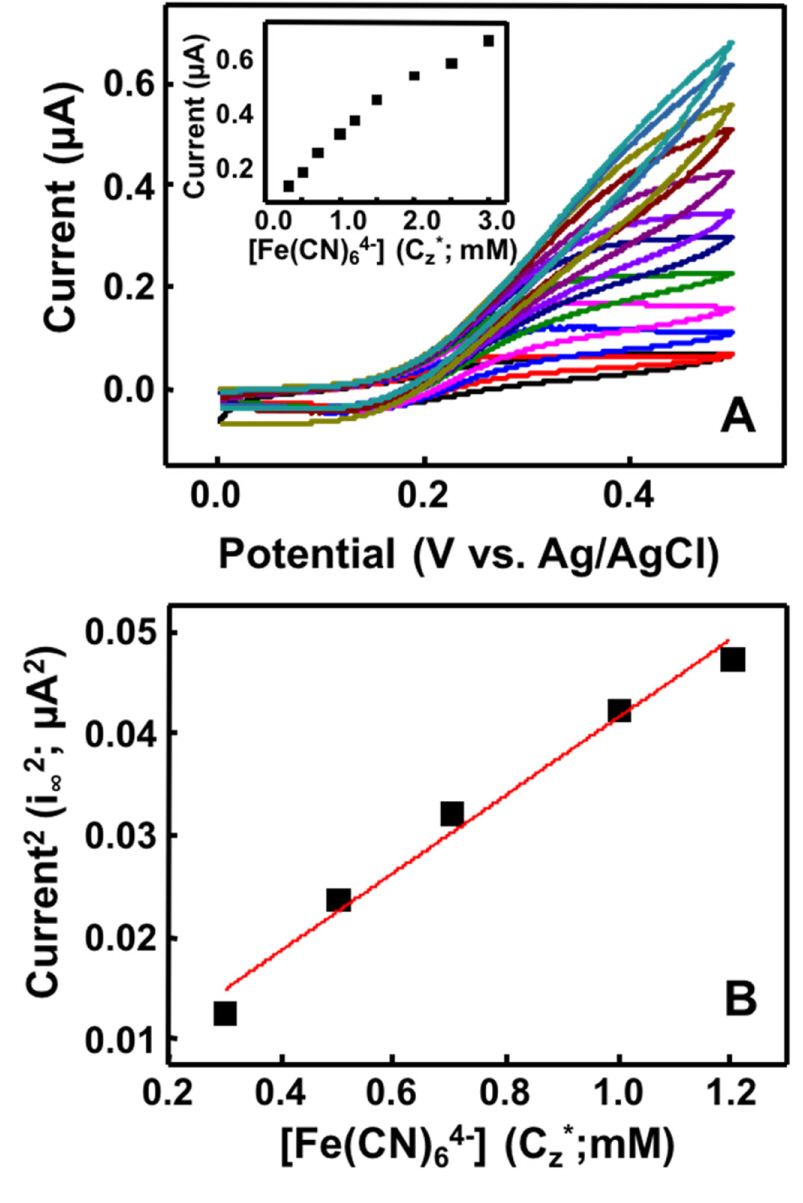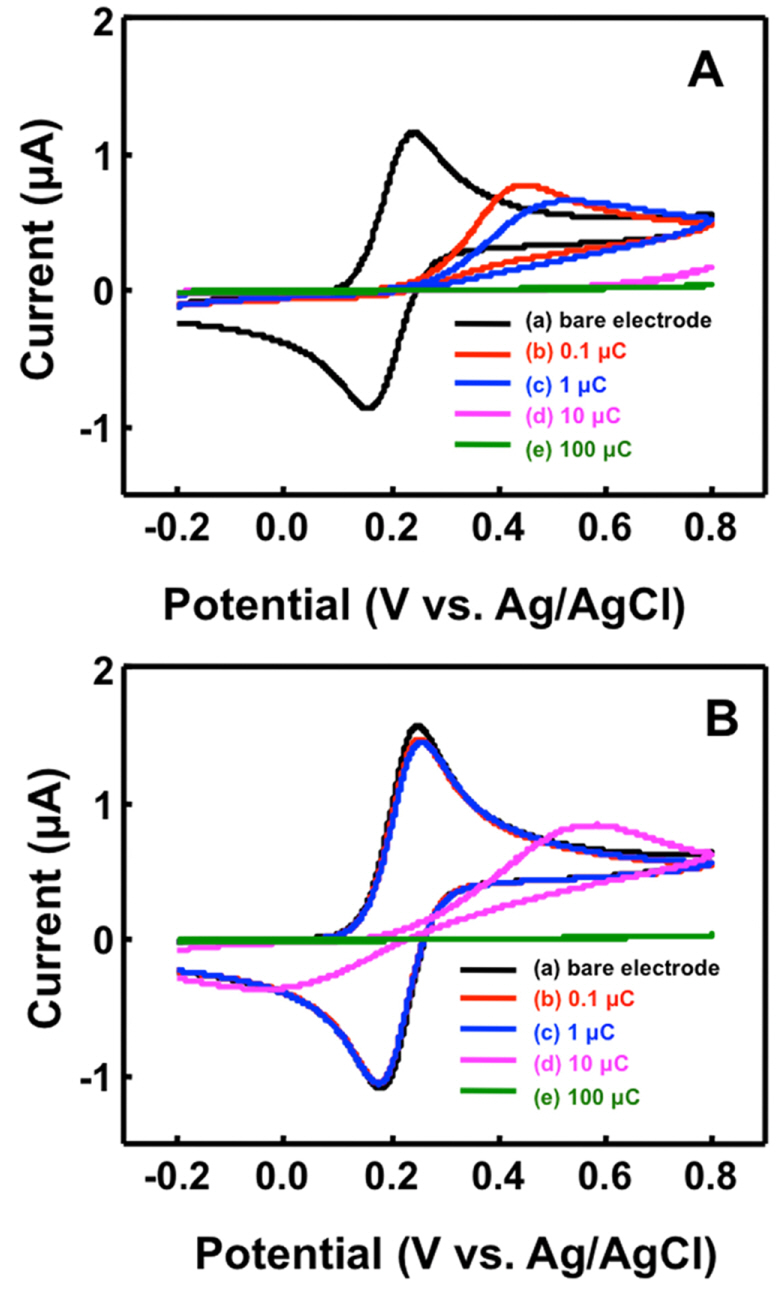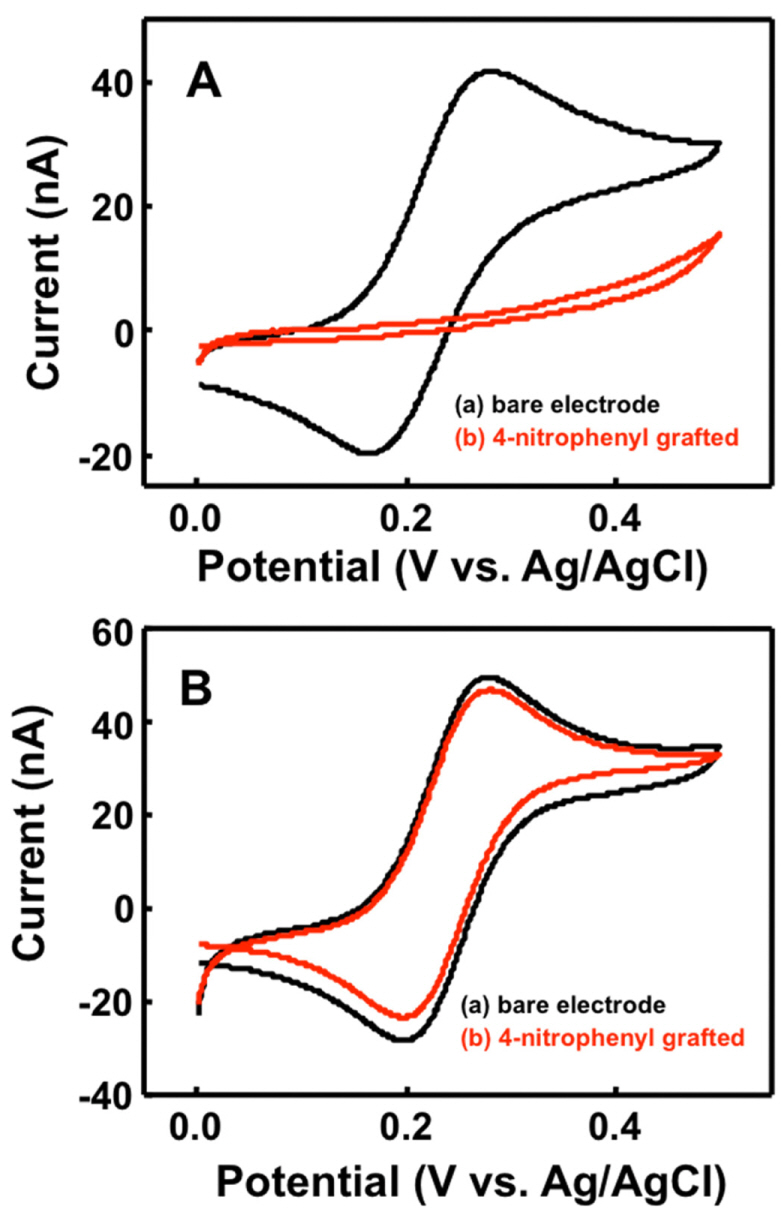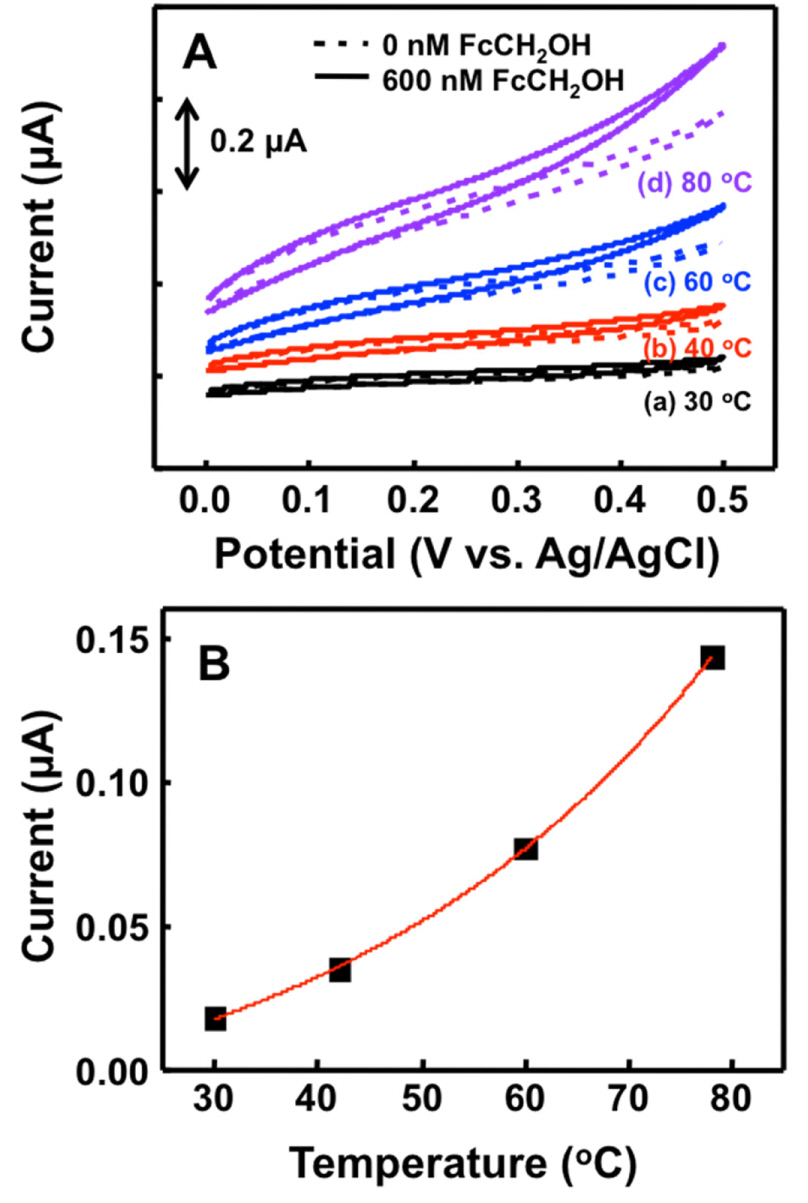1. Introduction
In bioanalytical fields, the quantitative analysis methods commonly rely on labeling the biological compound of interest with a fluorophore as a reporter. Despite all benefits of the fluorescence-based methods, this technique is suffered from high-cost due to the complex and expensive optical instrumentation. Alternatively, the electrochemical detection thus draws attention because of the low-cost, fast response, simple design and compact instrumentation that hold a possibility of miniaturization and portability of devices. However, the electrochemical signal from single redox label provides only one or two electrons and the double-layer charging limits the sensitivity of detection. Therefore chemical amplification has studied as a way of enhancing the electrochemical signal and thus improving its sensitivity [1-9]. In the chemical amplification, an amplifier-a reagent enabling electron transfer with the oxidized or reduced form of the analytepresents in solution while the reaction is kinetically suppressed or blocked on the electrode surface. Consequently, a redox active compound (i.e., analyte) cycles its electrochemical reaction on the surface of electrode resulting in an increase of local concentration and thus enhancing the sensitivity of detection without affecting on background current.
The chemically amplified electrochemical detection of ferrocene derivatives reported in the aqueous/organic solvent interface as well as aqueous solution employing an alkanethiol self-assembled monolayer on a gold electrode [10-11]. Signal amplification factors were obtained in several hundred to thousands facilitating a flow injection in a concentration range between 10−4 and 10−7 M. A lower detection limit of chemical amplification was studied with tris(2,2’-bipyridyl)dichlororuthenium(II) hexahydrate as the redox analyte and sodium oxalate as the electron donor on the ITO glass electrodes demonstrating a lower detection limit of approximately 50 nM [9]. However, further improvement is required to achieve real-time electrochemical detection for biological determination.
Herein we report a chemically amplified electrochemical ferrocenemethanol (FcCH2OH) detection system amplified by ferrocyanide (Fe(CN)64−) on the glassy carbon electrode grafted 4-nitrophenyl group. Ferrocenemethanol were detected in an nM range with good linearity using a linear sweep voltammetry after an optimized the extent of electrode surface modification, temperature, and the concentration of chemical amplifiers, ferrocyanide. This studied detection scheme benefits in the bioanalytical analysis due to the potential of the ferrocenemethanol that easily can be functionalized and linked with a biological analyte (e.g., DNA) with high stability.
2. Experimental Section
2.1. Reagents
4-Nitrobenzenediazonium tetrafluoroborate, ferrocenemethanol, potassium ferrocyanide were purchased from Sigma-Aldrich. The buffer solution (10 mM Tris-Cl, 45 mM KCl, 3.5 mM MgCl2; pH 8.5 adjusted with 1 M HCl) was used as an electrolyte solution preparing with distilled/deionized water (18 MΩ/cm).
2.2. Electrochemical instrumentations
A potentiostat (CHI 900; CH Instruments, TX) run the cyclic voltammetry employing the electrochemical three-compartment cell consisted of a glassy carbon electrode as a working electrode, a platinum electrode as an auxiliary electrode and an Ag/AgCl (3 M KCl) electrode as references. The glassy carbon disk electrode were made in laboratory using a glassy carbon rod (dia. 1 mm; Hochtemperatur-Werkstoffe GmbH) or purchased from BAS (dia. 3 mm). The electrodes were prepared by polishing with a 0.3 micron and 0.05 micron alpha alumina (Buehler) on a polishing cloth (NANO-CLOTH®, Buhler) and sonicated in 50% ethanol solution for five minutes followed by rinsing with deionized water (Millipore).
2.3. Modification glassy carbon electrode with 4-nitrobenzenediazonium tetrafluoroborate
Chronoamperometry carried out electrochemical modification of the glassy carbon electrode in in an acetonitrile solution containing 10 mM 4-nitrobenzenediazonium tetrafluoroborate and 0.1 M tetrabutylamine hexafluorophosphorous (TBAPF6) at −1.0 V vs. Ag/AgCl. The 4-nitrophenyl modified electrodes were washed by rinsing with water and ultrasonicating for 5 minutes. Cyclic voltammetry confirmed the extent of the modification either in 1 mM ferrocyanide or ferrocenemethanol solution.
3. Results and Discussion
3.1. Preparation and characterization of 4-nitrobenzene modified glassy carbon electrode for chemically amplified electrochemical detection
The glassy carbon electrode grafted 4-nitrophenyl group provides selective electron transfer in a chemically amplified electrochemical detection system between the redox analyte and the chemical amplifier (Scheme 1). The grafted surface allowed for relatively facile electrochemical oxidation of the analyte, ferrocenemethanol, but inhibited a background current from the electron donor, ferrocyanide. The electrodes modified with diazonium salt using a chronoamperometry serve as great barrier layers to differentiate the electrochemical reaction [12-16]. This surface modification steps involve the formation of a diazonium radical, followed by the formation of a covalent bond to the glassy carbon electrode [12]. Therefore, the charge of diazonium reduction enables to control an extent of modification. Charges of 0.1−1 μC resulted in the modified electrode behaving electro-active to ferrocenemethanol and inhibited current in ferrocyanide. However, more than 10 μC reduction charge resulted over modification and thus blocked redox current of ferrocenemethanol as well as ferrocyanide (Fig. 1). Additionally, the extent of modification can be further optimized not only as a function of the reducing charge but also the concentration of diazonium solution and the reducing time and electrode potential [15]. Indeed, optimum charge (i.e., 2 μC) was found to exhibit the hydrophilic/hydrophobic interaction so that it blocked ferrocyanide but ferrocenemethanol, while modified with a 1 mm diameter glassy carbon electrode in 10 mM 4-nitrobenzenediazonium tetrafluoroborate and 0.1 M tetrabutylamine hexafluorophosphorous (TBAPF6) as an electrolyte in acetonitrile at −1.0 V vs. Ag/AgCl. As shown in Fig. 2, the resulted electrode inhibited anodic current of ferrocyanide at +0.3 V but barely affected electron transfer of ferrocenemethanol (target analyte) exhibiting electrochemical reaction as same as the bare electrode. Of note, the 4-nitrophenyl grafted electrode exploited selectivity to suppress the direct oxidation of ferrocyanide (hydrophilic) due to the hydrophobic surface character, thereby enabling the signal amplification scheme for ferrocenemethanol (slightly hydrophobic) detection [13].
Scheme 1.
The chemically amplified electrochemical detection system using a 4-nitrophenyl grafted electrode.

3.2. Chemical amplification of ferrocenemethanol, redox active analyte by ferrocyanide and ferricyanide as amplifiers
To be suitable for chemically amplified electrochemical detections, the electrode must enable a fast electron exchange with the redox analyte, but perform negligible electrochemical reactions with the electron donor (i.e., amplifier) [9]. The 4-nitrophenyl grafted glassy carbon electrode described above detected amplified anodic currents of ferrocenemethanol in the presence of ferrocyanide in an aqueous solution as an amplifier (Fig. 3). On this chemically amplified electrochemical detection mechanism, ferrocenemethanol has fast electrochemical reactions on modified electrode surfaces as well as fast electron transfer rate with ferrocyanide allowing the application of the EC’ mechanism [17].
Fig. 3.
(A) Cyclic voltammograms of 0.1 mM ferrocenemethanol in buffer solution (a) without and (c) with 10 mM ferrocyanide. (b) Cyclic voltammograms of 10 mM ferrocyanide in a reaction buffer in the absence of ferrocenemethanol. All cyclic voltammograms were collected with 4-nitrobenzendiazonium modified glassy carbon electrode as a working electrode. The scan rate was 50 mV/s at RT. (B) Cyclic voltammogram of various concentrations of ferrocenemethanol: (a) 0, (b) 0.075, (c) 0.150, and (d) 0.250 μM with 0.1 mM ferrocyanide. Insert plot indicates the calibration curve. The scan rate was 5 mV/s run at RT.

In the absence of ferrocyanide, cyclic voltammetry of 0.1 mM ferrocenemethanol displayed well-defined reversible oxidation and reduction peaks showing in Fig. 3A (a). After addition of 10 mM ferrocyanide, the anodic current increased considerably expressing a catalytic current (Fig. 3A (c)). The electro-catalytic reaction between ferrocenemethanol and ferrocyanide defined as the following [11]:
FcCH2OH + e− → FcCH2OH+
FcCH2OH+ + Fe(CN)64− → FcCH2OH + Fe(CN)63−
The ferrocenemethanol enabled to be detected in a sub-micromolar concentration range in the presence of ferrocyanide with good linearity at room temperature since ferrocyanide acts as an electron donor to amplify the electrochemical current of ferrocementhanol (Fig. 3B). The similar electrode potential of ferrocyanide and ferrocenemethanol (less than 10 mV apart), thermoneutral character, and rapid electron self-exchange rate constants allow desirable electron transfer and thus make this pair of reactants suitable for a chemically amplified electrochemical detection scheme [18-21].
3.3. Kinetics for electrochemical sensing in nM range
The chemically amplified electrochemical detection system rely on EC’ mechanism especially the catalytic reaction, ErC’i. The catalytic current increased as increase concentration of ferrocyanide and saturated at the level of hundred times larger than ferrocenemethanol (Fig. 4). According to ErC’i mechanism, the rate constant of the amplification of ferrocenemethanol by ferrocyanide can be determined by equation (1), where i∞ is limiting value of catalytic current; CO* and CZ* are concentration of ferrocenemethanol and ferrocyanide, respectively; k' is rate constant for chemical amplification reaction; n is number of electrons involved; F is the Faraday constant; A is electrode surface area; and D is diffusion coefficient of ferrocyanide [17].
Fig. 4.
(A) Cyclic voltammograms of 10 μM ferrocenemethanol in the presence of different concentrations of ferrocyanide ([Fe(CN)64−]: from 0 mM to 3.5 mM) in a buffer solution at a scan rate of 5 mV/s. Insert plot indicates the ipa vs. [Fe(CN)64−]. (B) The ipa2 vs. [Fe(CN)64−] plot to determine rate constant of amplification.

The rate constant of the amplification (k') was calculated by the slope of the plot of the oxidation current at 0.5 V as a function of the square concentration of the chemical amplifier (Fig. 4B). The rate constant of amplification between ferrocenemethanol and ferrocyanide (k') was determined as 3.81 × 10−2 M−1s−1.
Ferrocenemethanol detection was studied at various temperatures for sub-nM determination (Fig. 5). The efficiency of detection (ΔI; the current difference between 0 and 600 nM of FcCH2OH) was exponentially increased by increasing temperature as showing in Fig. 5B. The improvement of kinetics between ferrocenemethanol and ferrocyanide yield this sensitivity increase. The potential of ferrocyanide shifted negatively by a temperature coefficient of −1.3 mV/°C [22-23], resulting the electron transfer to ferrocenemethanol easier while the electrochemical character of ferrocenemethanol kept constant independent of temperature increase. Of note, the efficacy of blocking ferrocyanide on the modified electrode surface did not change by the temperature being increased.
3.4. Electrochemical sensing in nM range by chemical amplification
The chemically amplified electrochemical detection of ferrocenemethanol carried out in the nanomolar range according to the optimized criteria described above. The ferrocyanide-amplified electrochemical detection of dissolved ferrocenemethanol was dramatically increased at 60°C compared to the results at room temperature. In addition to the elevation of temperature, decreasing the concentration of ferrocyanide granted to detect extremely low concentrations of ferrocenemethanol at 60°C (Fig. 6). However, in the case with less amount of chemical amplifier, the high concentration detection was saturated (Fig. 6B). Approximately hundred times higher concentration of the amplifier than the concentration of electroactive analyte were suitable for greatest detection efficacy in this system. Indeed, limit of detection of 5 nM was achieved by optimizing kinetics of electron transfer and interaction of amplifier on the electrode surface by electrochemically modified glassy carbon electrode based on chemically amplified electrochemical detection.
Fig. 6.
(A) Linear sweep cyclic voltammograms of ferrocenemethanol from 7.5 to 250 nM with 10 μM ferrocyanide as a chemical amplifier at the scan rate of 5 mV/s, and the temperature was 60°C. (B) Calibration curve constructed with determined current at 0.180 V (vs. Ag/AgCl). Inset indicates the focused plot for low-range concentrations of ferrocenemethanol.

4. Conclusions
The combination of ferrocenemethanol (electrochemically active analyte), ferrocyanide, (sacrificial electron donor and chemical amplifier) and the 4-nitrophenyl grafted glassy carbon electrode provide a fundamental basis demonstrating chemically amplified electrochemical analysis. The extent of 4-nitrophenyl functions on the electrode surface was optimized to react with ferrocenemethanol but ferrocyanide by controlling the reduction charge of diazonium. The detection of solution-phase ferrocenemethanol by cyclic voltammetry and linear voltammetry showed excellent sensitivity and linearity. As increasing temperature, the electrode potential of ferrocyanide negatively shifts and thus drives the electron flow more favorably. Additionally, optimized the concentration of the chemical amplifier, hundred times more than the concentration of the redox analyte, make it possible to detect extremely low concentrations such as 5 nM.
Ferrocenemethanol derivatives with carboxylate or amine functional groups enabling to tether with biological molecules such as DNA and proteins can be synthesized and therefore have wide application potential as an electrochemical tag in biological detections. Additionally, ferrocenemethanol and ferrocyanide are chemically stable, relatively small molecule, and low cost. Various electrochemical detection methods (e.g., differential pulse voltammetry) may further result in improvement of detection while applying this detection scheme in complex biological solutions. Indeed, the chemically amplified electrochemical detection system studied here will be an attractive technique in biological detection systems.












